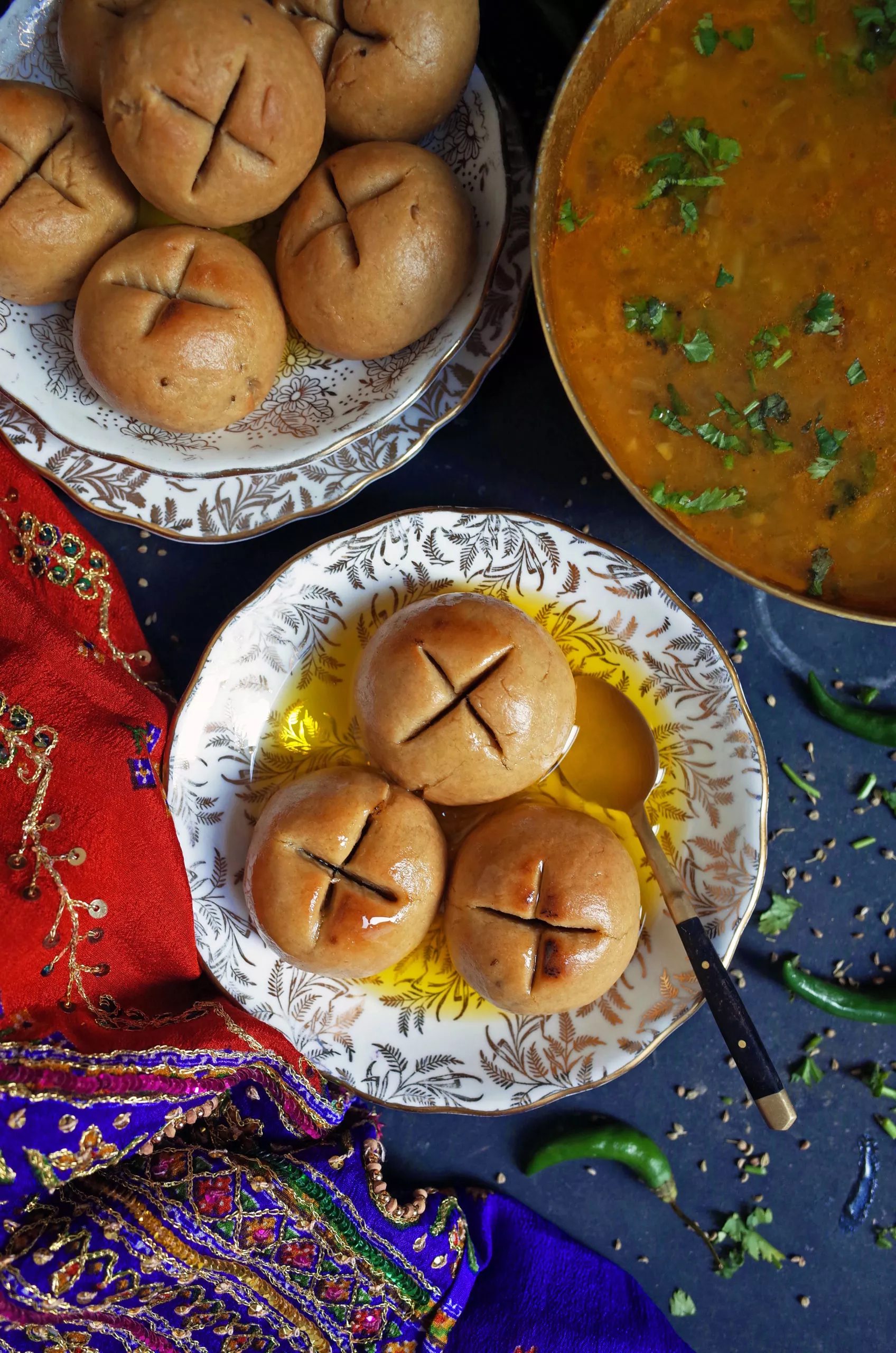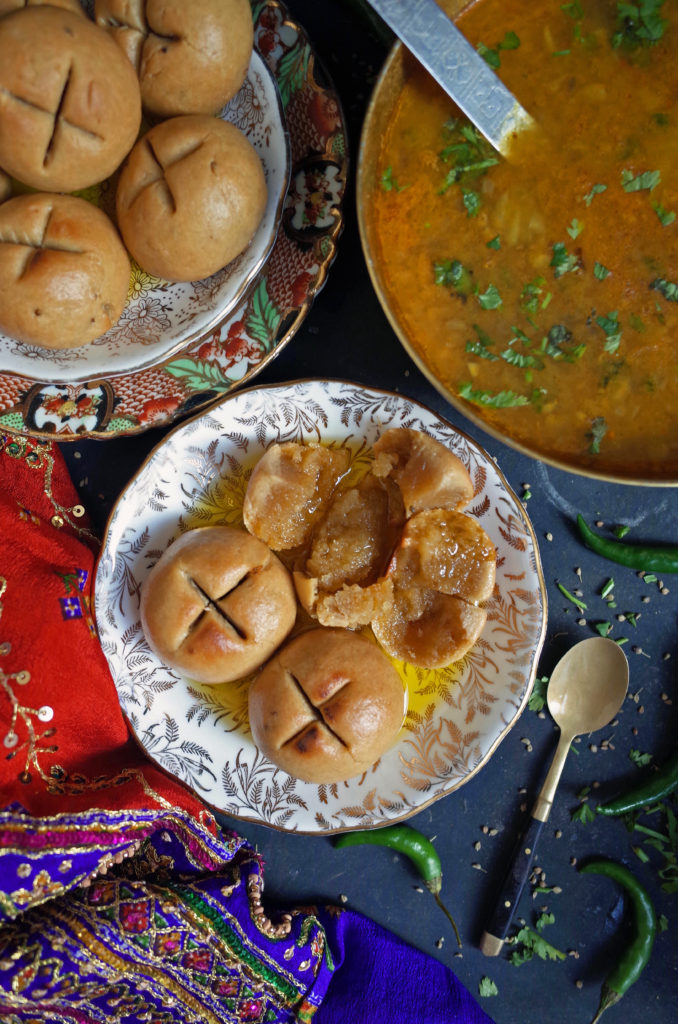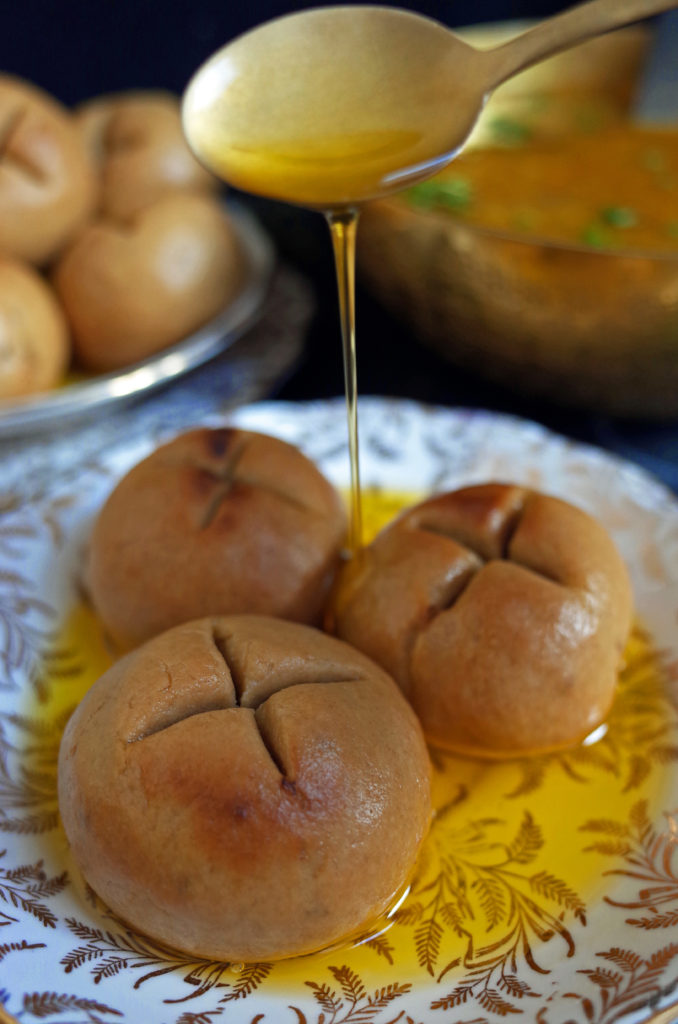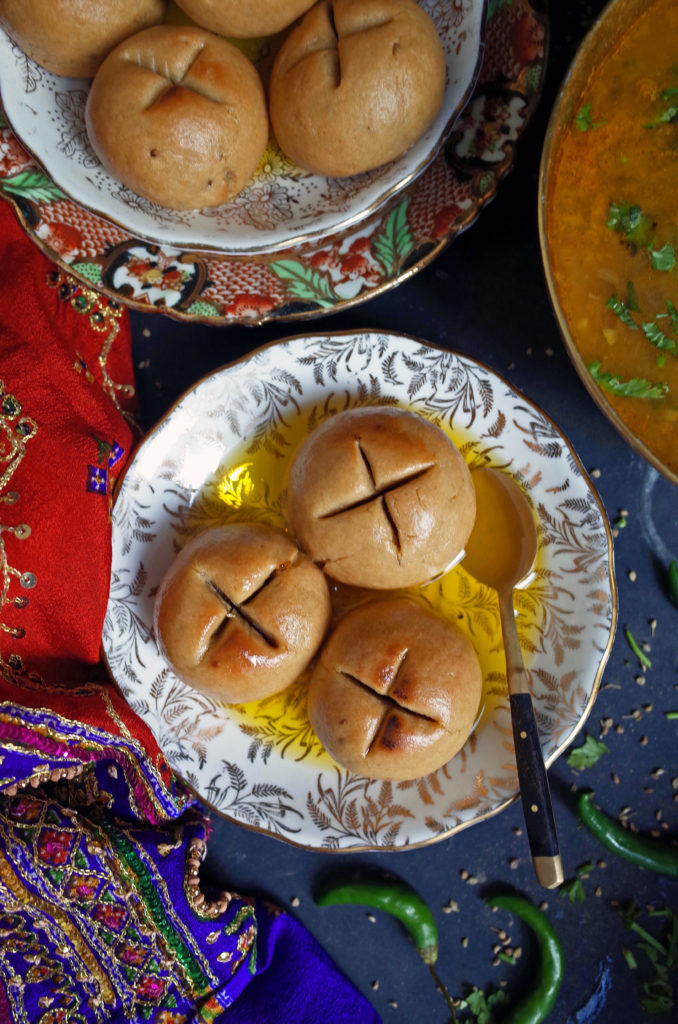Rajasthani Bati – Baked Indian Bread Rolls to go with Dal

Have you heard of Rajasthani Bati? Most people are familiar with Chapatis and Naan, but lesser-known Indian bread like Kulcha and Bati get left by the wayside! Bati is an unusual unleavened, hard bread that is traditionally made in the North-West Indian state of Rajasthan and served alongside a spicy lentil Dal and a sweet called Churma.
The Bati is traditionally cooked in an Earthen Oven and roasted on “dung cakes”! This is an interesting method of cooking frequently used in rural areas all around the world. The women of the village will collect cow (or buffalo) dung and shape it into balls which are then left to dry out. Subsequently, it’s eventually used as fuel, including to cook with. Don’t worry – today we’ll be using a normal oven!
Because the Bati is submerged in liberal amounts of golden buttery and aromatic ghee, the flavors soak through the bread so that every bite is sweetened with a hint of deep, rich creaminess. Moreover, the ajwain seeds added to the dough not only help with digestion but also add a pop of thyme-scented pungency.
Perhaps nothing in the world is more comforting than a pot of steaming dal and some good bread.
What is the story behind Dal Bati Churma?
Our story starts in the times of the Bappa Rawal, the founder of the Mewar kingdom during the Guhila dynasty of Rajasthan. It’s said that it is during this dynasty Bati was first discovered. In the hot and arid climate, the soldiers would bury dough-balls in the scorching desert sand every morning, and by the evening the burning midday sun would have cooked the Bati. They would then enjoy it dunked in ghee and served with Curd (fresh, thick yogurt). Who knows if these folk tales are true, but it does lend a certain romanticism to the meal! Most importantly, there’s no question that it’s essential to the cuisine and soul of Rajasthan.
Rajasthan – which quite literally means Land of the Kings – is well known for its cuisine which is highly influenced by the royal, extravagant meals of the Rajputs. The delicious combination of Panchmel Dal and Bati was said to have been brought into popularity during the Gupta dynasty and has been a mainstay in the cuisine ever since.
In modern-day India Rajasthani Bati, Dal, and Churma are relished on festivals, special occasions, and even birthdays. It’s a fairly heavy meal given the amount of ghee added so should be enjoyed as a delicacy. However, don’t be tempted to skimp on the ghee as it really makes the taste! You can read more about how to serve Bati further down the page.

Can you make these Rajasthani Bati Vegan?
These Bati are vegetarian and nut-free. However, they are not Vegan.
Theoretically, it’s possible to make Bati with oil instead of ghee to make a vegan version of the dish. However, ghee gives so much flavor to the end dish as it infuses the Bati with an unmistakable butteriness. I think a good way to make this dairy-free and vegan would be to use vegetable ghee. In short, this is essentially vegetable oil combined with a butter flavoring, which seems absolutely perfect in this situation.
What are the Variations of Bati?
Rajasthani Bati can be made in many different ways! However, this recipe is for a simple, plain Bati. Above all else, I enjoy these the most as it allow you to fully relish the aroma of the ghee which has penetrated into the dough, and don’t intrude on the incredible taste of the Dal which is served with it. That is to say, I would recommend making these plain Bati first and then if you want to experiment, you can also try these variations:
- Plain Bati (As in this recipe)
- Masala Bati: A Bati made with ground spices incorporated into the dough to create a spicy version
- Bharwa Masala Bati: A Bati which is stuffed with a spiced potato and onion mixture before baking
- Makke ki Bati: A lesser-known version made from cornmeal (maize flour)
- Bafla Bati: A softer version of Bati which is made by boiling and then baking the Bati.
Do let me know if you would like me to post the recipes for any of these variations in the future!

This Recipe is:
- Easy to follow
- Made from minimal ingredients
- Extremely indulgent!
- Truly delicious in it’s simplicity
Bati should always be served Fresh and Hot
Because these are a dense, unleavened bread, Bati always taste best when eaten fresh from the oven and served immediately. As a result they shouldn’t be stored for long periods of time – but if you can’t finish the Bati in one sitting you can store them at room temperature in an air-tight container and eat them the next day. Alternatively, you can use the leftover Bati and make Churma.

If you’re interested in more recipes for Indian bread, then do check out my Kulcha recipe – an easy oven-baked bread stuffed with delicious spiced potato.
[recipe title=”Rajasthani Bati – Baked Indian Bread Rolls to go with Dal” servings=”9 Bati” time=”40 mins” difficulty=”Easy”]
[recipe-ingredients]
- 260g Chakki Atta (Stone-Milled Chapati Flour)
- 1/4 tsp Salt
- 1/4 tsp Ajwain Seeds (Caraway/Carom Seeds)
- 4 tbsp Pure Ghee
- 125ml Water
- 6 tbsp Pure Ghee for soaking, optional
[/recipe-ingredients]
[recipe-directions]
- To make the Bati dough, add the chakki atta, salt and ajwain seeds* to a large bowl. Firstly, mix thoroughly to make sure the salt is evenly incorporated and then drizzle ghee into the bowl as well. Using your hands begin to work the mixture together, rubbing to create a crumbly sand-like texture. Slowly add water to the dough and knead into a very tight and firm dough. Do add the water slowly as depending on the quality and milling of your flour the quantity may be slightly different. I have used chakki atta so the qualities listed are for this specific flour.
- Rest the dough and pre-heat the oven. Cover the bowl and rest the dough for around 20-30 minutes at room temperature. Pre-heat the oven to 180 degrees Celsius.
- To shape the Bati, separate the dough into around 9 different balls. Take a ball and slowly work it in your hands to make a ball. Don’t worry if it’s not smooth or a bit rustic looking – this is a traditional recipe so perfection doesn’t matter much. Once all the balls are rolled, use a knife to carve a cross shape into the top of the Bati. This is to ensure the Bati get cooked from inside.
- To cook the Bati, place them onto a tray covered in parchment paper and put into the oven. Bake for around 20-30 minutes (this very much depends on your oven), or until the Bati are lightly golden on top.
- Remove from the oven. To get a nice smokey char, I held my Bati with tongs directly over the gas flame and allowed the tops to brown slightly. This step is completely optional and you can skip it. After that, dip the Bati in copious amounts of ghee before serving. Alternatively, if you want to be healthier just break the Bati and pour the Dal right over. Either way, eat hot.
[/recipe-directions]
[recipe-notes]
Note: If you want to make churma from any leftover Bati, don’t add ajwain seeds to your dough.
[/recipe-notes]
[/recipe]
What to Serve with Rajasthani Bati?
Before eating, dip or soak your Bati in ghee so they become softer on the inside and soak up all the delicious buttery flavours. Unlike other Indian breads which you eat by tearing off a section and scooping up your food, Dal Bati is eaten a little differently. Firstly break your Bati into coarse pieces and pour the dal on top, and then top with chopped raw onion (if you like).
Traditionally the Bati is served with a special platter of Panchmel Dal and Churma. Panchmel dal is an aromatic mix of five different lentils, while Churma is a dessert made from crumbled Bati (without Ajwain) mixed with sugar, ghee, mixed nuts and cardamon. On festive occasions, the addition of Lasoon ki Chutney (Garlic Chutney), Achaar (Pickles), Papad and even Rajasthani Kadhi may be added to the thali. The combination of all these dishes together is one not to be missed.
In other states across India, Bati can also be served with a variation of Baingan Bharta, a flame roasted and smokey Aubergine curry.
However, you don’t need to make an extravagant Rajasthani thali to enjoy the Bati. You can serve it with any dal of your choice, from Dal Tadka to Masoor Dal Fry.
In conclusion, if you have any questions please leave them in the comments down below and I will get back to you as soon as possible. Most importantly, if you give this recipe a try I would love to know what you think. Please take a photo and tag @ohmyvegofficial on Instagram or send it to any of my personal media accounts!

2 Comments